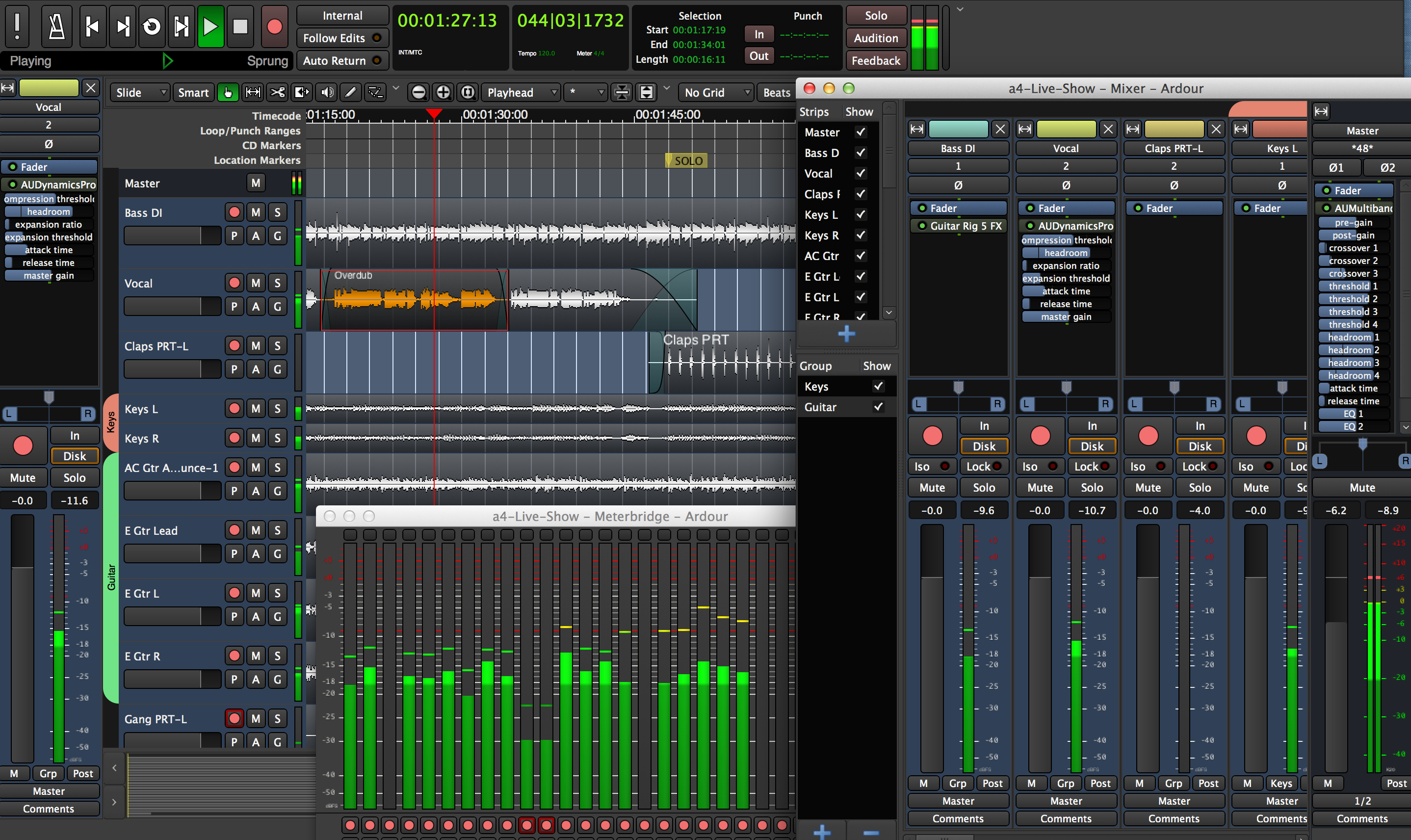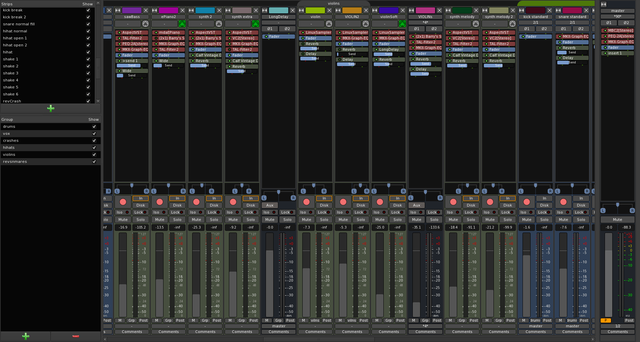Ardour 4.0 released
The Ardour project is pleased to announce the release of Ardour 4.0. This release brings many technical improvements, as well as new features and over a thousand bug fixes.
The biggest changes in this release:
- Better cross platform support. Ardour now runs on GNU/Linux, OS X and for the first time, Windows.
- JACK is no longer required, making it easier than ever for new users to get Ardour up and running (though JACK is still usable with Ardour).
- The user interface has seen a thorough overhaul, leading to a more modern and polished experience.
Additions and Changes
- Important Whole-Program Improvements
-
- the operating system's upper limit on the number of open files is now correctly used, avoiding issues with saving large sessions
- vastly reduced memory consumption. For an empty session Ardour now uses 80% less memory.
- User Interface
-
- The graphics technology used for the editing area of Ardour, and increasingly for many other parts of the user interface, has been completely reimplemented from scratch, using powerful, modern and cross-platform systems such as Cairo.
- the entire theming process has been redesigned to make it easier to alter the color palette used by the program. Any existing customized themes for Ardour 3 are no longer usable, so you will see the new defaults when running Ardour 4
- Most icons have been replaced with vector graphics and font-scaling has been overhauled
- Error window popup has been replaced with indicator button
- Audio and MIDI I/O
-
- Ardour 4 has completely abstracted all audio and MIDI I/O, and is no longer reliant on JACK for this function
- Ardour now comes with multiple "backends" that provide audio and MIDI I/O. These backends allow Ardour to use:
- JACK (available on all platforms if JACK is installed)
- ALSA (for use on Linux only)
- ASIO (for use on Windows only)
- CoreAudio (for use on OS X only)
- For developers and testers, there is also a "Dummy" backend which can be used to generate test signals and does not require an actual audio interface.
- Backends can be changed within a running instance of Ardour (e.g. from JACK to ALSA back to JACK)
- MIDI
-
- MIDI latency measurement
- Many, many improvements to MIDI editing and data handling
- Handle plugins with MIDI output
- Allow mixed data flow (MIDI+Audio) through an entire track or bus
- MIDI bounce is now functional
- New modeless editing model, with specific mouse tools/modes for drawing note and controller data as well as editing existing material.
- Transform dialog allows time-based transformation of note properies (like time, length, and velocity), such as velocity crescendos or chromatic scale runs
- New note velocity when adding with the mouse is based on surrounding notes
- Better handling of issues when importing various SMF (Standard MIDI Format) files
- Sub-bar level grid lines reflect grid unit choice
- 14 bit MIDI controller values correctly handled
- Editing
-
- New option to control which region(s) are selected after a split operation
- Axis limited dragging (Using the shift key during a region limits motion to initial direction (up/down or left/right) only
- Automation line editing notably improved
- Maximum zoom limited to 3 days @ 48kHz a 1600 pixel wide screen
- Ripple mode: this new editing mode can dramatically speed up your edits. In Ripple mode, audio regions after a move or delete operation will move to accommodate the edit.
- Cut (split) mouse tool (supplements the faster but more obscure use of the "s" (split) keybinding for users too stuck in the ways of legacy DAWs).
- Zoom mode removed (Select ranges/objects, then zoom)
- Drop zone: regions, selections and file drag-and-dropped to this area below all other tracks will create new tracks
- Track + region selection now mutually exclusive
- Remove all group active button (To operate on all tracks, use select-all-tracks (ctrl-t))
- Region name highlights removed (available as user-controlled option)
- Mute automation
- Vertical scrolling moves in units of whole tracks
- New "sequence regions" operation removes blank space between regions
- VST Plugin Support
-
- VST plugins (native Windows VST plugins on Windows, Linux VST plugins on Linux) are no longer automatically scanned at first application startup (this avoids plugins causing crashes when using Ardour for the first time on systems with misbehaving plugins already installed)
- An external scanning tool is used to identify and test VST plugins at user request from within Ardour
- Plugins which fail testing are placed on a blacklist so that they will not be loaded by Ardour unless manually overridden by the user
- OS X Platform Support
-
Unlike Ardour 3.x, Ardour 4.x is being officially released for OS X. Expect to see continued improvements to our OS X support in upcoming releases.
- Splash and dialog windows don't interrupt work flow
- MIDNAM files now included
- Screen positioning of AudioUnit GUIs is more rational and consistent
- Many more AudioUnit instrument ("soft synth") plugins can now be loaded successfully
- Prefer stereo variants of AudioUnit instrument plugins if one is available
- Fix AudioUnit Carbon GUI focus issues
- AudioUnit plugins are no longer automatically scanned at first application startup (this avoids plugins causing crashes when using Ardour for the first time on systems with misbehaving plugins already installed)
- Plugins which fail testing are placed on a blacklist so that they will not be loaded by Ardour unless manually overridden by the user
- Transport and Control
-
- Loop can now be a mode instead of an operation; if Loop Mode is engaged, then pressing Play (or space) will initiate the loop
- Tap tempo
- Q and W jump between markers
- Update clocks and video frames at the session video frame rate
- Big clock window now scales smoothly and correctly on all platforms
- Mackie Control
-
- QCon controller support
- Original Mackie Control device support
- Enable correct transmission of UTF-8 text to Mackie Control devices
- Miscellaneous
-
- Soundcloud Export
- Fix recording of files where the sample count exceeds the 32 bit limit
- Key bindings moved into Preferences
- Theme editor moved into Preferences
- Key binding rationalization
- Build system now works correctly with python3
- Improved support for LV2 controls and presets
- Remove several libraries previously maintained as part of the Ardour source tree
- New MIDI binding maps
-
- Akai MPK61
- New MIDNAM Support
-
- E-Mu XL-1
Developers
- The work on the new graphics engine was started by Carl Hetherington, and then later continued by Paul Davis, Robin Gareus, Ben Loftis, Nick Mainsbridge, David Robillard
- Abstracting the audio I/O was initially funded by Waves Audio who also provided the ASIO and the initial version of CoreAudio backends. Robin Gareus implemented the ALSA, current CoreAudio and Dummy backends.
- Improvements to MIDI editing were done primarily by David Robillard with input from Robin Gareus and Paul Davis
- The Windows port was originally funded by Google as part of a Summer of Code project carried out by Tim Mayberry, and was further developed by John Emmas to launch Harrison's Mixbus. Subsequent work on the Windows port and cross-platform portability in general has continued in the hands of Tim, Robin Gareus, John Emmas, Paul Davis, Grygorii Zharun and Valeriy Khaminsky
- Other contributors, in addition to those named above: Colin Fletcher, Ygvgeny Primakov, Jeremy Carter, George Krause, Todd Naugle, Devin Pohly, Guido Aulisi, Julien de Kozak, Michael Fisher, Sakari Bergen, Adrian Knoth, Hans Baier, Thomas Brand
- Paul Davis thanks Waves Audio for financial support during the development of Ardour 4, and their use of Ardour as the basis for Tracks Live.
- The ongoing open-source development of Ardour's Windows and OS X releases, UI improvements, and plugin hosting were largely funded by Harrison Consoles. Ardour 4 will serve as the platform for Harrison's upcoming release of Mixbus v3.



